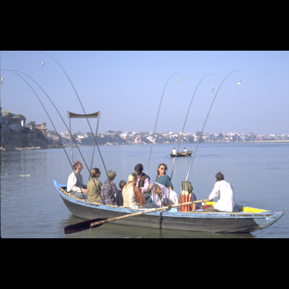
wind bow
1981 Lewiston, NY Temporary work formerly at Artpark in Lewiston NY explores the synergy of site, sound and design. Materials include: an earth-banked chamber, steel pole and 60 stainless steel strings tensioned by a laminated wood arc. This work was designed to attune the ear to the soundscape of the Niagara Gorge. Dimensions:12′ X 14′ X 5′.
The harp transforms wind energy into musical sounds known as aeolian tones, named after Aeolus, the god of wind in Greek mythology. The wind harp is one of the oldest musical instruments discovered by man. According to legend, King David hung his harp in an open window and heard it played by the wind. In more recent times, aeolian tones can be heard singing from telephone and power lines. When an aeolian harp string is activated by the wind, the fundamental is never sounded, only the overtone series. Wind velocity is directly related to the pitch heard by the listener; the greater the wind speed, the higher the activated overtone. The resulting tones have a shimmering, ringing quality.
In accordance with the laws of fluid dynamics, when air flows past a cylinder (in this case, a string), it sheds vortices to either side. These are shed in a stable and alternating pattern. When the frequency of this oscillation matches the frequency to which the string is tuned, an aeolian tone will result. The string always vibrates in a direction perpendicular to the wind.

aeolian garden
Installation at the campus entrance circle incorporates artifacts from a garden previously at the site. A stone fountain was transformed into an aeolian harp. Commissioned through the Art in Public Spaces Program of the Connecticut Commission on the Arts. 2000

adirondack sound field
Wires radiating from a central architectural listening post transmitted the aeolian sounds of a 4 acre field to the listeners ear. This was our first attempt to tune and activate a topography with aeolian strings

wind antenna
1982 New York CityTemporary work formerly at Art on the Beach, NYC. The aluminum parabolic dish functions as a resonator and provides ideal focus of wave frequency transmissions. Wind Antenna uses both mast and parabolic dish to convert wind energy into sound waves. Dimensions:15′ X 8′ X 8′.

wind antenna
Temporary work formerly on Lake Michigan for the New Music America Festival in Chicago. The aluminum parabolic dish functions as a resonator and provides focus of wave frequency transmissions. 1983

harmonic compass
1983 Lexington, NY Temporary work formerly at Lexington, NY. An architectural sound structure in which the tuning system is generated by the topography of the Lexington Valley. Wires ranging in length from 20′ to 250′ are tensioned between five galvanized steel poles and a delta-shaped resonator/shelter at the top of the hill.”https://www.youtube.com/watch?v=ZP6GXbEFID8&t=21s”

wind pavilion
1995 Zanesville, OhioAeolian harp at the International Center for Wild Animals (the Wilds), a 9000 acre wildlife refuge in Central Ohio. The work offers shelter and seating for visitors as they listen to the sounds of the wind. The cedar pavilion reflects the shape of the octagonal earth mound at the Hopewell Indian site in Newark, Ohio. Eight copper and teakwood harps are tensioned with stainless steel strings. Built in collaboration with Skip Stander and Charles Bremer.

sound vessel

1996 Varanasi, India A performance/installation on the Ganges River in Varanasi, India for the Sound Sattra Festival. A rowboat equipped with a wind harp, underwater microphone and contact mikes on the oarlocks ferried passengers along the bathing ghats on shore. For the finale, the Mallick family of musicians led by Biddu Mallick, sang North Indian Dhrupad songs while floating along the river.
